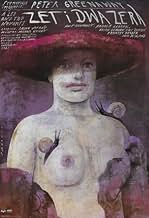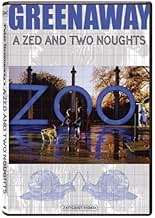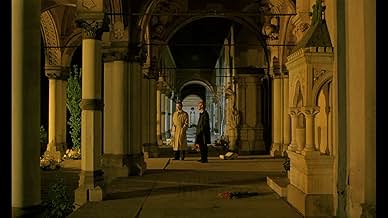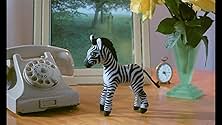Les zoologistes jumeaux perdent leur femme dans un accident de voiture et deviennent obsédés par les animaux en décomposition.Les zoologistes jumeaux perdent leur femme dans un accident de voiture et deviennent obsédés par les animaux en décomposition.Les zoologistes jumeaux perdent leur femme dans un accident de voiture et deviennent obsédés par les animaux en décomposition.
- Réalisation
- Scénario
- Casting principal
Avis à la une
This is definitely one of the more disgusting films I've watched, and not in a good way. This movie made me physically ill, and though it was mind-bending and beautifully coreographed, the subject matter and the lead characters' inevitable decline into utter insanity that is characteristic of Greenaway films was a bit much for me. I'm saying this and I loved Santa Sangre. Go figure.
A pair of twin brothers (who have different hair color somehow, and as it turns out were originally Siamese twins) become obsessed with the subjects of decay, evolution, and greif when their wives are killed in a car crash at the Zoo. They start conducting utterly repulsive experiments that involve time-elapse films of animals and fruits rotting away. And to top it all off, there's a plot in all of this, by a couple of poachers posing as zoo staff who plan to make a profit from all this. The rest is just entirely too disgusting/weird/complicated to explain clearly, but I will give you some hints about the ending: It involves a rack. And snails. And floodlights. And a record player.
A pair of twin brothers (who have different hair color somehow, and as it turns out were originally Siamese twins) become obsessed with the subjects of decay, evolution, and greif when their wives are killed in a car crash at the Zoo. They start conducting utterly repulsive experiments that involve time-elapse films of animals and fruits rotting away. And to top it all off, there's a plot in all of this, by a couple of poachers posing as zoo staff who plan to make a profit from all this. The rest is just entirely too disgusting/weird/complicated to explain clearly, but I will give you some hints about the ending: It involves a rack. And snails. And floodlights. And a record player.
Greenaway's obsessions with lists, wordplay, coincidence, sexuality, the surreal, and the explicit (not to mention the "conventionally used" ones like men and women, birth and eating and death, physiology (formal and psychological), and abstraction) come to a head in this film. A bizarre mileau of fancy digressions and focused narrativity create a film which is perhaps too obtuse for first time viewers but is, as far as I'm concerned, the best way to initiate oneself into the "world" of Greenaway.
All you need to make cinema is a point of view (and of course the view to which it points). Or a frame of reference and the reference which it frames. In Greenaway all these exist together, knowingly, as forms within forms.
A story of twins looking to overcome grief by studying the decay of death is the reference here. Zebras, lizards, swans, we see the empty shells of body decay before the camera. Kept under the scrutiny of our gaze in life, inside cages, they remain under it once dead. At what point do all these symmetries which conjoined together make up the miracle of life stop being the sum of their parts, and by which process; how much of these parts that we understand as the self can be taken out before the self is no longer recognized; and the symmetry once broken, what mystery renews it.
These obscure ruminations are framed against the question of existence, which implies god and pattern. How come that something so systemised, so perfectly designed and evolved from nothing, from amoeba and algea, can come to pass by the whim of chance? Having taken millions of years for creation to unravel its complexity, why does it take a second to destroy it? Which is to ask, at what point does the system, which in hindsight appears ordained and patterned, become random and meaningless.
Various eccentricities are enacted in this process, all pointing to some kind of symbolic nakedness.
When the legless woman gives birth to new life, twins again, the old twins, the blueprint for them, must step aside. The film ends with an poignant thought. Having carefully staged their own death so that the decay that follows may be captured on film, we see how nature intrudes upon this scene and foils the effort.
An atheist himself, Greenaway here gives us a pessimism that cuts deep; no consciousness survives this.
A story of twins looking to overcome grief by studying the decay of death is the reference here. Zebras, lizards, swans, we see the empty shells of body decay before the camera. Kept under the scrutiny of our gaze in life, inside cages, they remain under it once dead. At what point do all these symmetries which conjoined together make up the miracle of life stop being the sum of their parts, and by which process; how much of these parts that we understand as the self can be taken out before the self is no longer recognized; and the symmetry once broken, what mystery renews it.
These obscure ruminations are framed against the question of existence, which implies god and pattern. How come that something so systemised, so perfectly designed and evolved from nothing, from amoeba and algea, can come to pass by the whim of chance? Having taken millions of years for creation to unravel its complexity, why does it take a second to destroy it? Which is to ask, at what point does the system, which in hindsight appears ordained and patterned, become random and meaningless.
Various eccentricities are enacted in this process, all pointing to some kind of symbolic nakedness.
When the legless woman gives birth to new life, twins again, the old twins, the blueprint for them, must step aside. The film ends with an poignant thought. Having carefully staged their own death so that the decay that follows may be captured on film, we see how nature intrudes upon this scene and foils the effort.
An atheist himself, Greenaway here gives us a pessimism that cuts deep; no consciousness survives this.
(Movie quote) - "So, tell me - Is a zebra a white animal with black stripes, or is it a black animal with white stripes?"
Even though I definitely found this 1985, British, "art" film to be something of a "hit'n'miss" production, it was its very striking camera-work by French cinematographer, Sacha Vierny, that certainly helped to elevate it to a position that set it well-beyond the realm of being considered just purely mundane entertainment.
Surreal, eccentric and bizarre (and, yes, at times, quite puzzling) - "A Zed And 2 Noughts" definitely had me wondering, often enough, what kind of a curve director Peter Greenaway was going to hurl at me next with this weird and somewhat disturbing tale of obsession with decaying flesh and the amputation of body parts.
Certainly not a film to please everyone (and certainly not a film with a gripping plot-line) - I, for one, thought "A Zed And 2 Noughts" was well-worth a view simply for the freakish biology lesson that it quite cleverly wedged into its wacky, little story (all at no extra cost).
Even though I definitely found this 1985, British, "art" film to be something of a "hit'n'miss" production, it was its very striking camera-work by French cinematographer, Sacha Vierny, that certainly helped to elevate it to a position that set it well-beyond the realm of being considered just purely mundane entertainment.
Surreal, eccentric and bizarre (and, yes, at times, quite puzzling) - "A Zed And 2 Noughts" definitely had me wondering, often enough, what kind of a curve director Peter Greenaway was going to hurl at me next with this weird and somewhat disturbing tale of obsession with decaying flesh and the amputation of body parts.
Certainly not a film to please everyone (and certainly not a film with a gripping plot-line) - I, for one, thought "A Zed And 2 Noughts" was well-worth a view simply for the freakish biology lesson that it quite cleverly wedged into its wacky, little story (all at no extra cost).
A rewarding post modern film about life and decay and the effects of a single moment on a person's life. Great sets and photography by the legendary cinematographer Sacha Vierny, this film makes you ultra aware that you are watching a film, or a sort of theatrical filmed piece. Greenaway is an aquired but very rewarding taste, and no other director makes films as he does. A disturbing somber film for serious fans of modern cinema. Greenaway is a must in your education of film.
Le saviez-vous
- AnecdotesThis film was Peter Greenaway's first collaboration with cinematographer Sacha Vierny, who went on to shoot virtually all of Greenaway's work in the 1980s and 1990s, until Vierny's death in 2001. Greenaway referred to Vierny as his "most important collaborator".
- Citations
Alba Bewick: In the land of the legless the one-legged woman is queen.
- ConnexionsFeatured in Peter Greenaway (1992)
- Bandes originalesThe Teddy Bears' Picnic
Music by John W. Bratton
Lyrics by Jimmy Kennedy
Performed by The BBC Dance Orchestra
Directed by Henry Hall
Courtesy of EMI MUSIC PUBLISHING LTD and EMI RECORDS LTD
Also sung by Venus De Milo (Frances Barber)
Meilleurs choix
Connectez-vous pour évaluer et suivre la liste de favoris afin de recevoir des recommandations personnalisées
- How long is A Zed & Two Noughts?Alimenté par Alexa
Détails
- Date de sortie
- Pays d’origine
- Langues
- Aussi connu sous le nom de
- A Zed & Two Noughts
- Lieux de tournage
- Sociétés de production
- Voir plus de crédits d'entreprise sur IMDbPro
Contribuer à cette page
Suggérer une modification ou ajouter du contenu manquant





























